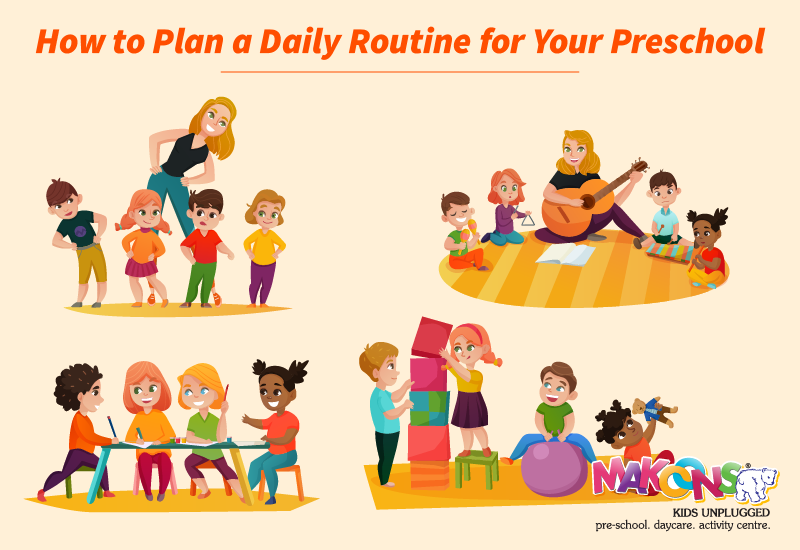In the happy chaos of a preschool classroom, Routine is the only thread that keeps everything together. Toddlers benefit the most from routine and structure. A well-designed routine of a preschool increases confidence, independence, and learning in young brains in addition to making life more easier for teachers. A chaos free, stimulating, and child-centered learning environment can be implanted with careful preschool schedule planning, without thinking of whether you are a new preschool owner or a experience one .
Let’s walk through how to plan a child-centered preschool routine that truly works—for both kids and teachers.
Why a Daily Routine Matters in Preschool
Toddlers’ brains crave rhythm, they don’t wear watches. A predictable daily schedule for kids gives them a sense of control and also emotional security. When kids already know what comes next they feel safe —whether it’s snack time or story time. Safe kids are more likely to explore, engage, and learn.
In short, routine can never be restrictive—it’s freeing.
Step 1: First understand kid’s Natural Rhythms
Before hoping into blocks of time, observe your children carefully
- When do they feel most energetic?
- When do they need their downtime?
- How long can they stay focused before losing interest in an activity?
The foundation of Children – centered preschool routine is based on
An observation-based approach .For example, if your kids are mostly active early in the day, then start with physical play rather than circle time. Tailoring your timetable according to their needs ensures more joy and little resistance.
Step 2: Set Clear Anchors points Throughout the Day
Children benefit more from anchor points—consistent activities always help mark time. These mostly include:
- Arrival and free play
- Circle time or group discussion
- structured activity time
- Snack or meal breaks
- Outdoor/gross motor play
- Rest time
These pointers serve as signposts throughout the whole day. Kids know what’s coming next, and that makes transitions much easier.
Step 3: Make a Flexible yet a Consistent Schedule
Yes, toddlers need consistency—but they also need flexibility in a schedule. We know that every day won’t go as we planned. Some of the kids may skip a nap, another one might need extra attention, or a fire drill may sometimes interrupt lunch time. The trick is to have a preschool daily routine that is structured but also forgiving.
Build in transition buffers. Keep activities little short (10–20 minutes for toddlers) and always allow a room for adjustment because what if . Keep in mind that children don’t wear out because of structure—they wear out from being rushed.
Step 4: Balance both Active and Quiet Times
This is one of the most important elements of effective preschool timetable planning. Too many high-energy tasks back-to-back can sometimes lead to meltdowns. On the other hand, too many quiet and calm tasks can lead to boredom.
Here’s an ideal rhythm for this:
- Start day with an active task (e.g., outdoor play)
- Follow with a calming one (e.g., group reading or puzzle time)
- Alternating between stimulation and relaxation throughout the day makes it easier for both kids and educators.
This gentle ebb and flow mirrors how toddlers function naturally. It keeps toddlers calm, engaged, and emotionally regulated.
Step 5: Don’t take Transition Times for granted
In the schedules for adults, transitions are minor. But for small kids , shifting from one activity to another is a big deal. If you don’t plan for transitions in advance, you’ll spend most of your day trying to manage kids .
Use songs and countdowns. Give children some time to wind down from one task before starting into another one . Even a five-minute heads-up—“In five minutes, we’ll clean up and get ready for snacks”—can work like a wonder. This type of approach is deeply implanted in a child-centered preschool routine where children are treated with empathy and with respect.
Step 6: Include Open-Ended Play and Free Choice
Some preschool routines are so packed with activities, they forget the most important part: which is free play.
Free play is never a waste of time. It’s when a kid processes emotions, builds social skills, and makes sense to the world. Whether it’s just building blocks, role playing in a kitchen ( ,pretend), or simply drawing, this time is sacred.
Always allocate at least 30–45 minutes daily for self direct play. It makes your daily schedule for toddlers more emotionally supportive.
Step 7: Always Keep Parents in the Loop
When you share the routine with parents, they can mirror parts of it at home because consistency doesn’t end at the preschool gate. This also strengthens emotional security in toddlers and creates a bridge of balance between home and school.
Share regular updates, photos, or a basic outline of the day in your monthly parent teacher meeting. This implants trust and transparency.
Sample Flow for a Child-Centered Preschool Daily Routine:
- 8:30 AM – 9:00 AM: Arrival time
- 9:00 AM – 9:20 AM: Circle time
- 9:20 AM – 10:00 AM: Learning centers
- 10:00 AM – 10:30 AM: Snack break time
- 10:30 AM – 11:15 AM: Outdoor play
- 11:15 AM – 11:45 AM: Sensory play like art and music
- 11:45 AM – 12:15 PM: Story time and wind-down
- 12:15 PM onwards: Pick-up
Final Thoughts
Keep your Child always at the Center
When you’re deeply into preschool timetable planning, it is tempting to build a day that suits the teachers well. But always remember: the best routines are never built around the clock , it always revolves around the clock.
A child-centered preschool routine reduces behavioral issues among kids , builds trust, and makes learning more joyful and exciting . And that, at the end of the day, is what early education is truly about.
So, go forward —build a routine that works for your child ,and watch your preschool flourish with time.
Read Also: What Makes a Preschool Great? Tips for Parents to Select the Best One

